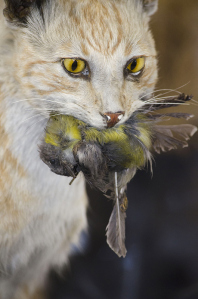By Thomas Evans
Following my recent blog regarding the control of invasive alien species, I want to take a look at one particular animal that’s been receiving a great deal of media attention of late – the feral cat. According to the Australian Wildlife Conservancy (AWC), there are somewhere in the region of 20 million feral cats in Australia… and they kill about 75 million native Australian animals every night.
Extinction crisis

A feral cat and prey. Source: The State of Victoria
Australia has the worst rate of mammal extinctions on the planet, with 29 since European settlement. That’s about 10% of Australia’s original mammal fauna, including mice, bandicoots, potoroos, bettongs, rats, a wallaby and one of Australia’s only two bilby species – and marauding moggies are the principal culprits.
It is estimated that an individual feral cat kills an average of five animals every night – with some killing many more. Journalists in Australia recently published a controversial photograph showing a culled cat alongside the contents of its stomach (a vast array of dead animals). It’s a graphic image, but they argue that given the dire state of Australia’s wildlife, publishing the photo was justified. I’m inclined to agree – the image conveys an important message. You can access the article (and the photo) here (warning: graphic image).
The Action Plan for Australian Mammals, published earlier this year, represents the first comprehensive assessment of the conservation status of mammals across Australia – it identifies feral cats as the most significant threat to their survival. Furthermore, predation by feral cats is now listed as a key threatening process under the Environment Protection and Biodiversity Conservation Act 1999 (EPBC Act), which specifically identifies 35 bird species, 36 mammals, seven reptiles and three amphibians to which feral cats represent a specific threat. Evidence also suggests that feral cats are on the verge of causing a second wave of extinctions in Australia’s north – the nation’s sole remaining landscape reflecting Australian biodiversity prior to the arrival of Europeans.
You get the picture – one of only two continents in the world with no native cat species is now the world’s largest cattery.
Time is running out, but for whom?
It seems shameful that 20 million feral cats are still able to run riot in a relatively stable and wealthy country, which without doubt has the capacity to deal with the issue. So what’s being done about it?
Last Wednesday, the Federal Environment Minster, Greg Hunt, set out a plan to halt the loss of Australian mammals in Australia by 2020. At the centre of this plan is a pledge to eradicate all significant feral cat populations. Presumably this is because the Australian Government recognises that if it is going to make any progress towards meeting its 2020 biodiversity targets, signed up to under the Convention on Biological Diversity (CBD), then feral cats have to go. All hail the power of the multilateral agreement.

John Gould print image of the Pig-footed Bandicoot – a species extinction largely attributed to feral cat predation. Source: Museum of Victoria
Landscape management
In truth, there may be sites where a program of targeted baiting could be successful in reducing feral cat populations. However, it is unlikely to work in isolation. Australia is an enormous continent – baiting simply isn’t feasible. What’s needed is a range of techniques to deal with feral cats, including the broader management of Australia’s landscapes. The Victorian Government is currently progressing with plans to introduce the Tasmanian Devil into Wilsons Promontory National Park. The proposition here is that this top predator will compete with feral cats (and foxes) for food and nesting space, and may also take their young, reducing feral cat populations. Interestingly, Hunt recently acknowledged that he had not heard about the Victorian Government’s proposals, which perhaps suggests that Australia has yet to develop a coordinated national approach to deal with feral cats.
The cat-proof fence
Another approach that has proved successful in recent years is the establishment of a network of cat-proof enclosures. The AWC manages 23 properties, covering three million hectares of cat free land, with successful results for native species. One out of every five wild greater bilbys, and one of every three numbats now live within these enclosures. The AWC is currently constructing a 43 km fence to create the largest cat (and fox) free area on mainland Australia, with the aim being to reintroduce nine of Australia’s most endangered mammal species. The message here is that when feral cats are removed, wildlife bounces back.
I leave you with a final quote from the Chief Executive of the AWC, Atticus Flemming:
“…if we remove feral cats from the landscape, we will see massive increases in the numbers of native animals… You wander at night through those areas where we’ve eradicated feral cats, and it’s like stepping back 200 years. The bush is alive. There are bilbys everywhere, bettongs everywhere, bridled nailtail wallabies. The ground is moving with little animals. That is what the bush must have been like before there were foxes and cats.”
Sounds purrfect to me.


You must be logged in to post a comment.